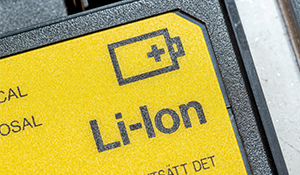Lithium-ion (LI) batteries are an integral part of modern society, powering everything from...
Measuring Contamination in Hydraulic Fluids
Hydraulic fluid contamination is one of the most serious concerns for pump failure. Foreign particles, like dust, rust, or water, that become entrapped in the hydraulic fluid will damage the pump and negatively impact system performance and can lead to critical failures. This is especially problematic for mission critical systems in applications like aviation. There are many sources of hydraulic fluid contamination including corrosion, damaged filters, and seal failures. The severity of hydraulic pump failure is directly related to the size and quantity of solid particles present.

How do particle contaminants damage your pump?
When contamination is mostly small particles, like airborne dust, it will accumulate in between the moving parts of the hydraulic system and create friction. This will increase the component wear and leads to corrosion and other damage. When the contamination is large particles, fluid leakage or blockage is possible, resulting in poor system performance or even catastrophic failure.
Reliable system operation requires monitoring and control of the contaminants in the hydraulic fluid. Qualitative and quantitative determination of the particulate contaminants both require precision in obtaining the fluid sample and in determining the contaminant particle size distribution and concentration. Liquid automatic particle counters (APC) are an industry accepted means of determining the concentration and size distribution of any contaminant particles.
Calibrating an automatic particle counter
Typically, APC instruments determine the number of particles in a liquid using the principle of Light Extinction where the particle count is based on the disruption to the transmission of light in the system. The accuracy of APC is established and maintained through a regular cadence of calibration.
ISO 11171 is the industry accepted standard calibration procedure for particle counting applications in hydraulic fluids, aviation and diesel fuels, and other petroleum-based fluids, This standard outlines the requirements for primary particle-sizing calibration and establishes the acceptable performance limits for instrumentation. According to ISO 11171, the primary calibration must be performed using NIST SRM 2806, however, the method also includes instructions for the preparation of secondary calibrations. Secondary calibration standards can be used to monitor instrument performance in between primary calibrations and offer a more economical option for calibration when more than one APC is in use in a lab.
Important considerations when choosing a calibration standard
While there are commercial secondary calibration standards available, it is important to consider the following when selecting a standard for use:
Does the calibration standard comply with the current revision of ISO 11171?
ISO 11171 is periodically reviewed and updated. It is critical that a secondary standard meets the current method requirements to ensure it is fit for purpose.

Is the manufacturer ISO 17034 accredited?
ISO 17034 defines the requirements for the production of reference materials and the competence of reference material manufacturers. An ISO 17034 accreditation indicates that the manufacturer of the reference material has been audited by an independent third party and was found to be compliant with the rigorous requirements of the ISO standard.
What information is included on the certificate of analysis?
It is important to evaluate the certificate of analysis that is provided with the product and confirm it meets your data requirements. Questions to ask include: How many size channels are reported? Does the manufacturer include certified values and the associated uncertainty? What NIST SRM was used to calibrate the primary APC used during the manufacturing of the standards?
Conostan Reference Materials
Conostan® is an established and leading brand of petroleum reference materials, originating as a division of ConocoPhillips in the 1970’s and acquired by SCP Science in 2007. SCP Science joined the AnalytiChem family of companies in 2022, continuing the legacy of producing high quality standards for petroleum applications. 
These ISO 17034 accredited reference materials cover a complete range of petroleum matrices and applications from lubricating oils to fuels and oil condition monitoring.
PartiStanTM is the Conostan® range of calibration fluids for automatic particle counters. These calibration fluids include super clean blanks and calibration standards traceable to NIST 2806 and covering a range of particle sizes including 3, 4, 6, 10, 14, 21, and 30 µm. These reference materials are ideal for measuring particles in hydraulic fluids according the ISO 11171 as well as other applications for measuring particulate contamination in fluids.
Conclusion
The hydraulic pump is generally the most critical and expensive component on a hydraulic system. The most common cause of hydraulic pump failure is contamination. A robust oil monitoring program that includes particle count analysis is essential to ensure the reliable performance of the hydraulic system and to avoid costly downtime, unexpected repairs or catastrophic failure.
References
- ISO 11170:2013, Hydraulic fluid power; https://www.iso.org/obp/ui/#iso:std:iso:11170:ed-3:v1:en
- Effects of Hydraulic Pump Contamination and Failure Prevention; https://whyps.com/hydraulic-pump-contamination-and-prevention
- Causes of Hydraulic Pump Failures, Noria Corporation; Causes of Hydraulic Pump Failures | Machinery Lubrication
- Particle counter; Particle counter – Wikipedia
- How the New ISO Particle Count Standard Will Affect You; https://www.machinerylubrication.com/Read/12/iso-particle-count
- Fluid Contamination, Cat® Products; "The Silent Thief" – YouTube




.png?width=50&name=MicrosoftTeams-image%20(1).png)

